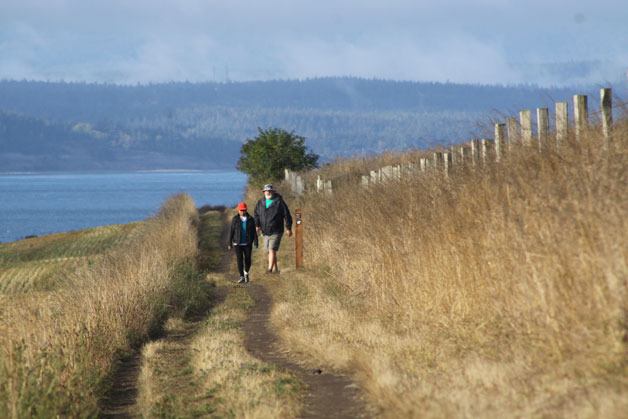As Dave Penrod and his wife Josie navigated the final stretch of a new hiking trail in Coupeville, his face was illuminated by the morning sun and an uplifting thought.
“The rush is over,” he said. “We finally have this to ourselves.”
The Penrods enjoy the walking trails in Coupeville and are tickled with the Pratt Loop Trail, which opened last month above the ridge overlooking Ebey’s Prairie.
With summer winding down and the weather shifting, Dave Penrod acknowledged that the number of tourists visiting Whidbey Island will drop, leaving the island’s scenic attractions mostly for residents to enjoy.
“This particular trail is an easy walk,” he said. “It’s picturesque. It’s well maintained. The people who did this should be applauded.”
The Pratt Loop Trail is a creation of Ebey’s Landing National Historic Reserve, which timed its opening, as well as the unveiling of three new interpretive panels, with a celebration for the National Park Service centennial anniversary in Coupeville on Aug. 25.
The trail was the product of work by reserve members, community volunteers and the Northwest Youth Corps.
It is named after Coupeville’s Pratt family, which owned hundreds of acres of land above the prairie and along the bluff for most of the 20th century.
The trail loop covers 1.3 miles, including a portion carved through the wooded Robert Y. Pratt Preserve named after the man who grew up on the land and ultimately donated much of it upon his death in 1999 to The Nature Conservancy and other organizations.
His father was Frank Pratt Jr., a Coupeville millionaire who acquired properties that contained historically significant structures that he wanted to see preserved. The Ferry House and Jacob Ebey House, now owned by the National Park Service, were among the purchases of Frank Pratt Jr., who died in 1939.
The Pratt Loop Trail takes visitors around the vast property once owned by the Pratts and includes a few remnants such as an old sheep barn and machine shed, both believed to have been built in the 1930s.
But, mostly, the loop’s appeal comes from its scenic vistas and a significant link — it connects two popular trail systems for the first time.
The Pratt Loop Trail connects to a spur to the Kettles Trails system on one end and to the Ebey’s Prairie Ridge Trail on the other. The ridge trail leads directly to the well-traveled bluff trail near Ebey’s Landing.
That means, for serious hikers, there’s now a way to get from the Kettles to the bluff without straying from a hiking path.
Providing greater public access to the former Pratt property has been in the plans ever since the National Park Service acquired the land, said Kristen Griffin, manager for Ebey’s Landing National Historical Reserve.
A parking lot located at the reserve’s administration office at the end of Cemetery Road was expanded last year to address the rising popularity of hikers and visitors to the historic Jacob Ebey House. The lot is essentially a trailhead for those interested in taking on the Pratt Loop or setting out for adjoining trails.
A permanent restroom is being planned for the site next year to replace the portable toilet, said Roy Zipp, operations manager for the reserve.
“One thing we’re really having a lot of discussion with right now is, as we all start experiencing increasing visitation here, it really becomes more important that people really pay attention to the signs,” Griffin said. “For example, obviously the Pratt Preserve is a nature preserve, so it’s intended to protect the animals and plants. So it’s really essential that dogs be onleash.”
The pedestrian-only Pratt Loop Trail doesn’t start in the woods.
It begins at the reserve parking lot next to a field of alfalfa leased by Ebey Road Farm and follows a grass-covered path beside a long hedgerow that follows the fence line of Don and Deb Sherman’s farm.
The straight path leads to the woods and the old sheep barn, which is off-limits to the public. If you continued in that direction, you’d find the spur that connects to the Kettles Trails system.
The Pratt Loop Trail veers to the left in front of the barn, passes the collapsing machine shed and continues along the nature preserve to an opening that offers a bench and sweeping view of both land and sea, including passing ships in Admiralty Inlet.
From there, the path returns to the darkness of the woods ands takes hikers along a primitive trail through a tunnel of trees and oceanspray shrubs.
Decaying logs riddled with holes made by woodpeckers are everywhere in the preserve, named after a man who studied insects and amassed a collection of more than 1,000 specimens, mostly beetles, that were donated to the Pacific Rim Institute of Environmental Stewardship.
Robert Y. Pratt was even co-author of a scientific paper published in the June 1938 Journal of the New York Entomological Society, reporting about the diet of black widow spiders found on the bluff near Ebey’s Landing back then.
There are doubts whether black widows still exist on the bluff and its unique microclimate.
Emerging from the woods on the Pratt Loop Trail, one encounters the trail’s most sweeping view of the prairie and saltwater.
And sometimes more.
Coupeville’s Karen Bishop of Ebey Road Farm remembers one particular evening earlier this summer when she and her husband Wilbur went out to visit the incomplete trail and looked to the south and saw sunlight reflecting off tall buildings.
In Seattle.
“You could actually see the buildings in Seattle,” she said.



